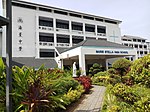Woodleigh MRT station

Woodleigh MRT station is an underground Mass Rapid Transit (MRT) station on the North East line (NEL), in Bidadari, Singapore. The station is underneath Upper Serangoon Road, near the junction with Upper Aljunied Road. Surrounding points of interest include Stamford American International School, Avon Park and the Mount Vernon Columbarium. The station will serve the developing Bidadari Estate and Woodleigh Residences. Woodleigh was first announced along with the 16 NEL stations in March 1996. Though it was completed along with the rest of the NEL in June 2003, the station remained closed due to the lack of local developments. It eventually opened in June 2011. As with most of the NEL stations, it is a designated Civil Defence shelter. Woodleigh station features an Art-in-Transit public artwork Slow Motion by April Ng, depicting commuters going about their daily lives on 30 zinc panels.
Excerpt from the Wikipedia article Woodleigh MRT station (License: CC BY-SA 3.0, Authors, Images).Woodleigh MRT station
Upper Serangoon Road, Singapore Toa Payoh
Geographical coordinates (GPS) Address External links Nearby Places Show on map
Geographical coordinates (GPS)
| Latitude | Longitude |
|---|---|
| N 1.339181 ° | E 103.870744 ° |
Address
Woodleigh
Upper Serangoon Road
357741 Singapore, Toa Payoh
Singapore
Open on Google Maps







